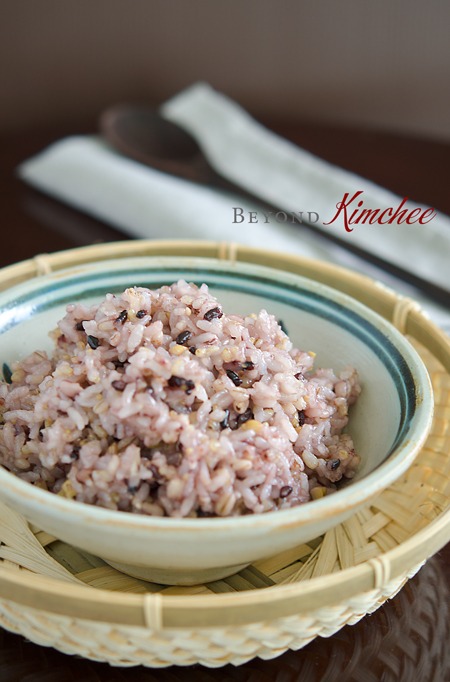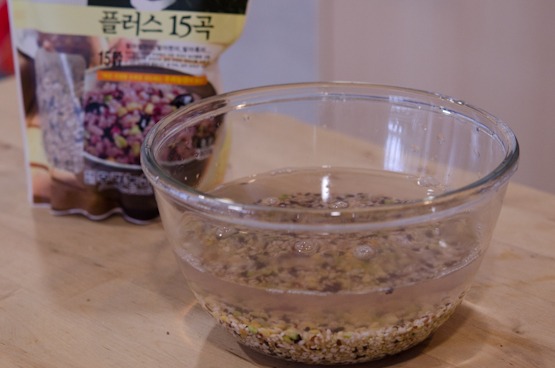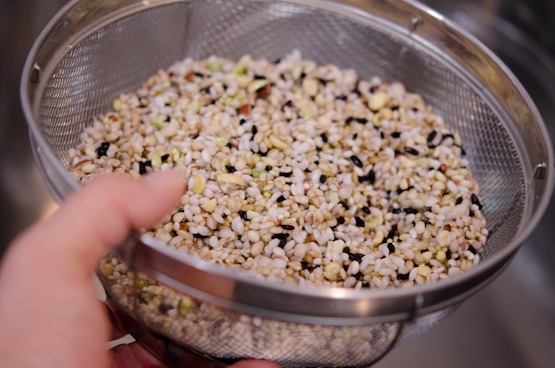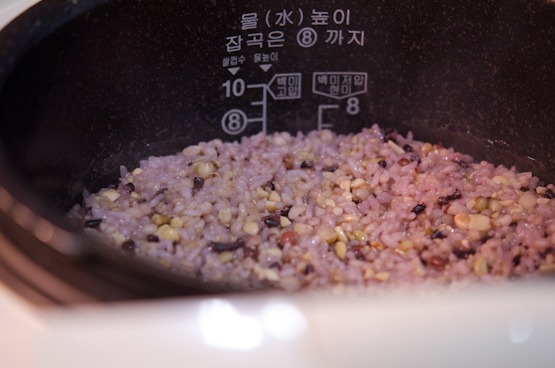Multigrain Rice (Japgokbap)
Korean Multigrain Rice, also known as Japgokbap, is a wholesome blend of oat, barley, millet, sorghum, brown rice, legumes, and white rice. This nutrient-rich dish offers a harmonious combination of grains and legumes, creating a well-rounded and satisfying meal.

“Your recipe for multigrain rice is the best and easiest to follow from any recipe I’ve seen. Thank you!”
Donna Mikasa
If you enjoy Korean cuisine, you’ve likely noticed that many Koreans prefer multigrain rice (japgokbap, 잡곡밥) over white rice. Mixing grains and legumes in your rice offers numerous benefits.
Multigrain rice offers a healthier alternative to white rice by incorporating a variety of grains and legumes. It provides greater nutritional value and avoids the rapid sugar conversion associated with white rice.
While the advantages of consuming multigrain or wholegrain are abundant, transitioning directly from white rice to 100% brown rice can be challenging. Brown rice alone may not offer the desired flavor profile. That’s where the mixture of white rice and assorted grains comes in.
By gradually increasing the amount of multigrain and reducing the white rice portion, you can ease into the transition. My preferred ratio is about 70% multigrain and 30% white rice. This flavorful option complements many Korean main dishes.

What Is Multigrain Rice?
Multigrain rice, also known as japgokbap (잡곡밥), is a nutritious and flavorful rice dish that combines various grains and legumes. It offers a variety of textures, flavors, and health benefits compared to traditional white rice.
Here are some common grains that are often included in multigrain rice:
- Brown rice
- Glutinous brown rice
- Black rice
- Rice bran
- Various beans (green, red, black, kidney, black-eyed, soy, etc.)
- Split peas
- Oat
- Barley
- Sorghum
- Millet
By incorporating these diverse grains, this mixed wholegrain rice provides a wholesome and well-rounded meal option. Experiment with different combinations of grains to find your preferred blend and enjoy the nutritional advantages of this rice.

Jeongwol Daeboreum Tradition and Ogokbap
Korean mixed grain rice is not only a staple in Korean cuisine but also holds cultural significance during Jeongwol Daeboreum (정월대보름), a traditional celebration that takes place on January 15th of the lunar calendar.
During Jeongwol Daeboreum, Koreans traditionally prepare ogokbap (오곡밥), which translates to “five grain rice.” This special version of multigrain rice consists of five key grains, including glutinous rice, black rice, millet, sorghum, and beans. The combination of these grains symbolizes abundance, good fortune, and health for the upcoming year.

Tips for Selecting and Preparing Multigrain Rice
When selecting a multigrain rice package, I recommend avoiding those with an excessive amount of kidney beans. In my experience, beans in such packages can be too dried out or overpowering in flavor.
Instead, feel free to add your preferred beans of choice. Personally, I enjoy incorporating fresh beans and even nuts like walnuts or almonds for added texture and taste.
For today’s recipe, I’ll be using 1-1/2 cups of these mixed grains along with 2 cups of white rice. If you’re new to multigrain rice, this ratio is a great starting point.
As you become accustomed to the flavors, you can adjust the amount of grains to suit your personal taste preferences.

Choosing the Right Cookware
When it comes to preparing japgokbap, having the right kitchen appliance is crucial for achieving optimal results. One of the best options is a pressure cooker, which ensures that your grains are cooked to perfection with a soft yet chewy texture.
Here are two options to consider:
- Electric pressure rice cooker: This fully automated appliance requires just a push of a button, taking care of the cooking process for you. However, it comes with a higher price tag (around USD$400 and above). If you frequently cook multigrain rice, it can be a worthwhile investment.
- Stovetop Pressure Cooker:
This option is much more affordable (around $70 for a good-quality one). With a stovetop pressure cooker, you have the flexibility to manually adjust the cooking time and heat. While it may require a bit of practice initially, you’ll soon become comfortable using it.
Update: Another popular option these days is using an electric pressure cooker, such as an Instant pot. The cooking method is similar, where you manually set the cooking time (around 15 minutes) and release the steam manually as well.
Pressure cookers offer versatility beyond just cooking rice. You can also use them to prepare porridge, oatmeal, beans, and more. With the right cookware, you’ll be able to achieve the perfect texture and flavor for your rice dishes.
How to cook multigrain rice


Rinse 1-1/2 cups of mixed grains several times and soak in water for at least 30 minutes (I soaked mine for 1 hour). Drain the soaked grains.

In a separate bowl, rinse 2 cups of white rice. Combine the drained mixed grains and rinsed white rice together.

Pour 4 cups of water into the rice mixture. The ideal ratio of rice (un-soaked) to water is 1:1.5 based on regular white rice cooked in a regular cooker. Adjust the water amount according to your desired texture.
Note: Adjust the water amount and cooking time based on your preferred texture and the type of cooker you are using. Experiment with different water amounts for stove top cooking to find your ideal result.

If using an electric pressure cooker, select the multi-grain option or set the cooking time to approximately 35 minutes.
If using a stove top cooker, bring the mixture to a boil over high heat until you hear the hissing sound and the tab on the lid shakes.
Then, reduce the heat to low and simmer for 5-7 minutes. Turn off the heat and wait until all the steam has been released.


Once cooked, fluff the rice with a fork. Serve and enjoy the nutritious and wholesome grains.
Freezing Tips

If you have leftover rice, it’s a great idea to store it in the freezer for later use. Simply place the rice in a ziplock bag and freeze it. When you’re ready to enjoy it again, remove the rice from the bag and reheat it in the microwave for 2-3 minutes. It will taste just as delicious as freshly cooked rice.
Keep in mind that if you plan to use the rice the next day, storing it in the fridge is an option. However, rice tends to lose moisture quickly after one day, which can make it become crumbly and tasteless. So, freezing is the best way to preserve its quality.

Stay tuned for my next post, where I will share an amazing recipe for “Ssambap” a Korean rice wrap filled with an assortment of lettuce and a delectable topping sauce. It’s the perfect complement to enjoy with this delicious rice.
More Korean Dishes to accompany japgokbap
- Spicy Pork Bulgogi (Jeyuk Bokkeum)
- Classic Bulgogi Recipe (Korean Beef)
- Classic Doenjang Jjigae (Soybean Paste Stew)
- Authentic Pork Kimchi Stew (Kimchi Jjigae)
- Grilled Mackerel Fish in a Parchment Paper

Multigrain Rice (Japgokbap)
Ingredients
- 1-1/2 cup assorted mixed grains, short grain brown rice, black rice, millet, barley, sorghum, oat, legumes etc
- 2 cups white short grain rice
- 4 cups water, use less if you prefer firm and chewier texture
Equipment
Instructions
- Rinse 1-1/2 cups of mixed grains several times and soak in water for at least 30 minutes (I soaked mine for 1 hour). Drain the soaked grains.
- In a separate bowl, rinse 2 cups of white rice.
- Combine the drained mixed grains and rinsed white rice together. Pour 4 cups of water into the rice mixture. The ideal ratio of rice (un-soaked) to water is 1:1.5 based on regular white rice cooked in a regular cooker. Adjust the water amount according to your desired texture.
- If using an electric pressure cooker, select the multi-grain option or set the cooking time to approximately 35 minutes. If using a stove top cooker, bring the mixture to a boil over high heat until you hear the hissing sound and the tab on the lid shakes. Then, reduce the heat to low and simmer for 5-7 minutes. Turn off the heat and wait until all the steam has been released.
- Once cooked, fluff the rice with a rice paddle. Serve and enjoy the nutritious and wholesome grains.
Notes
- For using an instant pot: cook multi-grain rice on manual setting for 15 minutes. Then release the steam on natural venting for 10 minutes, and turn the knob to quick release to escape all the steam.
- Freezing Tips: If you have leftover rice, simply place the rice in a ziplock bag and freeze it. When you’re ready to enjoy it again, remove the rice from the bag and reheat it in the microwave for 2-3 minutes. It will taste just as delicious as freshly cooked rice.


Your recipe for multigrain rice is the best and easiest to follow from any recipe I’ve seen. Thank you!
Hi Holly,
What would you recommend for cooking pressed barley with white rice in a rice cooker?
Amazing tips!!! I’ve got the exact same grains as you and thanks for the cooking instructions! 🙂
I see this type of rice more and more in korean dramas and often wondered if it was just rice and beans (like in latin dishes). Now I know. I’ll definitely have to give it a try and buy from my H-Mart store.
Hello, these posts are all so great!
I was wondering where I can purchase the baskets used to hold noodles or fried foods, or the ones used in the pictures on this article.
Thank you Holly for the information. I have been cooking a 12-grain rice blend since 2005 when I worked with a Korean lady named Hyonmi. I LOVE it…soo earthy, delicious and satisfying. I usually soak overnight and use a rice cooker. I only cook a small amount since it is just for myself. Sometimes, I toss a little butter in at the end, and I think it’s amazing. I never mix it with white rice, but it sounds like it could be good as well. I was wondering; Besides being a side dish of ‘purple rice’ what other uses would you suggest. Is this something that is only eaten on the side or are there Korean dishes such as soups, stir frys, etc that it is used in. Thanks!
I purchased a package of T&T 10 multigrain rice, I have soaked it for 2 hours like the package says. When I cook it in the rice cooker, I am clearly doing it wrong, perhaps too much water? It come out looking like mushy hot cereal not rice. Do I drain the water it was soaked in? how much water should I add to cook it in the rice cooker? I have a Hamilton Beach Rice cooker with a whole grain setting.
You don’t want to cook with the water you soaked your grains in. Drain the water off and pour new water but a lot less amount. With minimum of 2 hours of soak time, I would put about 1:1.5 ratio of grain and water. Some rice cooker with the whole grain setting turns the grains into a porridge. Try with the whole grain setting again and if it still turns into porridge, use the regular setting. Hope this helps.
Thank you very much, worked much better now. Hope you have a Blessed and Joyous New Year.
Argh… I had just made this but I had no idea that the grains needed to be soaked, especially since I used a regular rice cooker. Is what I made still edible?
As long as they are fully cooked to your taste, they are edible. If you soak the grain in the water, it cooks more evenly that you can enjoy the soft texture of the grains
Mmmm! Looks good! Can I just leave it in my cuckoo rice cookers eat it everyday instead of putting it in the freezer or will the taste go bad?
Also if I just want to make brown rice, how long do I soak it for and how long does it take in the cuckoo rice cooker? I’ve read somewhere 4 hours!
This is how I make it. I soak the 7 mixed multi-grain in water for 24hrs. Normally you’ll need 2-3x the amount of water as the rice, as they soak up alot. I put it in the refrig. Then I put it in my cuckoo for multi-grain setting. Here’s the key. Soaked rice only needs small amount of water. I usually pour the entire thing into the rice cooker pot and drain all the water up to the same level as rice. It’s comes out crunchy and soft. Even people are surprised how well it taste. You need 1:2 ratio because it’s not been soaked enough. I used to do this, but it doesn’t taste as good as soaking it in for 24 hours + and using less water during cooking. It usually cooks in 3hrs in my cuckoo.
Hi,
I bought the 7 mixed multigrain rice at hmart. My rice consists of brown rice, brown sweet rice, barley, red bean, black bean, black sweet rice, and mung bean. I had two bad attempts with cooking the rice. Both of my attempts were a big fail. I think I may have had the wrong water ratio. (I cooked it in a rice cooker under mixed rice settings).
Can you let me know the ratio of rice I should use and the water? I’m cooking for myself and I own a small zojirushi rice cooker with mixed rice settings. I like my rice to not be too dried nor too sticky.
Is it NECESSARILY to add white rice to the mixed rice? I mean my rice already have brown rice in it.
If you don’t have a pressure cooker and using ordinary rice cooker, I highly recommend to soak the grains in the water for at least 4 hours or overnight in the fridge. Soaking will help cook the grains evenly and thoroughly. I would use 1:2 grains and water ratio for the ordinary rice cooker.
I made it but it tastes bland. What vegetables and spices can we add to make it tasty, moist and complete in nutrition? Thanks.
This is a recipe for making multi-grain rice only, not a complete meal. It will taste bland without any dishes to go with.
Where can I find the multi-grains in Singapore?
Check Korean grocery stores. Or you can collect each grains separately from any grocery stores
There’s Seoul Mart in Bedok mall and other areas. They sell the grains rice!!
정말 너무 감사하고요 벌써 60줄 가까이 되지만 한국요리는 잘 하지못해 해본적이 별로 없었는데 Holly씨의 blog을 보고 김치를 담았는데 난생 처음으로 맛있게 잘 되어서 너무 기뻤어요. 앞으로도 좋은 요리법과 사진들 부탁들일께요
감사합니다. 도움이 될수있어서 기쁘네요.
growing up my brother and i would call this ‘purple rice’. so good!
My kids call it ‘purple rice’ as well. They like to eat their purple rice.
Really informative post. I haven’t had Wonder Bread for years (decades!) but I do like white rice, even though I know of its nutritional downside. I should start cooking with multigrains more. And a great excuse to buy a pressure cooker!
Hi, Holly. I have just discovered your blog (I came from Hyosun’s blog) and I’m amazed by the beauty of your photos and the fascinating dishes I see here. I want to cook everything you post (well at least all the Korean dishes because I am a beginner in Korean cuisine, but I love every single dish I discover and prepare). I am crazy for perilla, use it whenever I can and I see it here as a wrap with lettuce! What a fantastic idea! This multi grain rice looks very unusual! I hope I can find it one day here and taste.
Hi Sissi, welcome to my blog and thank you for the nice compliment. I love perilla leaves, too and lanning to post more dishes with them. Multi-grain rice is quite tasty and flavorful. I prefer over brown rice. Hope you get to give it a try.
I LOVE your site! I’m in the process of launching a Korean food blog. I’m excited to share my culture and food with other people. SO… I was just browsing your blog and saw that you’re LDS!! Totally cool! I am, too. Are you Korean as well? If so, we have so many things in common. 🙂 We’re Korean. We both love food. We both blog. And we are both LDS! ha
Hi Sook
Yes, I am a Korean, of course, and LDS living in overseas. Congratulations on your new blog. It is always nice to meet a new blogger especially who is sharing a similar interest. Wishing the best luck and let me know when you launch.
Holly, I am so glad you posted this. I have been blending different grains and rice for awhile, and my family loves it. I made an aromatic rice made from organic brown and red rice for dinner the other day. My daughter had a friend over and she ate three helpings…of course teenage kids might be a little more open to the idea. Anyway, why I am so glad to see your post is I have been using a mixed grains from my Korean store and I found the legumes in it were not cooked right. I am happy to find out how to use it in my pressure cooker, and soaking it is a key! Thanks! One question do you find the white rice gets overcooked when using it with brown rice and grains that need longer cooking time?
Hi Lyndsey
You want to soak your brown rice and other grains but not the white rice. I cook them together and they are fine. Grains that have been soaked will cook faster and that will even out the cooking time with white rice. The white rice adds the stickiness where the other grains won’t and helps to create soft chewing texture. If you use a stove top pressure cooker, you need to reduce the water amount more than the electrical automatic ones. I would start with small amount first to experiment and you will get a sense that how much grain:water ratio is the most ideal for you. Everyone has different preference on their rice texture. I like it softer side on the multi-grian.
Yum! I will definitely have to try this. I love seeing your blog posts. I’m Korean but never cook Korean food aside from re-heating what my mom makes for me. Your recipes inspire me to learn to do all of this on my own. Thank you!
thanks for the recipe! my mom used to make this rice sometimes when i was younger and i hated it… i even picked the beans out! now i LOVE it. sorry, mom. 😛
hehe….I gave up white rice (cold turkey style as you referred) long ago for the same reason you mentioned in your post. I usually prepare simple brown rice for my family. As you said, there’s not much flavor in them. I love your version of multi-grain. I bet it has better flavor than just plain brown rice. But my kids are so used to brown rice already, I think they can handle all brown rice with milti-grain. 🙂
Thanks Amy. If your families are tamed with brown rice, that is blessing! No need to go back to white rice. Adding some multi-grains is a fun change and delivers different flavor and texture. My family prefers multi-grain rice over brown rice alone.
This looks really good! It’s a lot healthier than white rice. I meant to change our rice to more healthier version but my kids and my husband refuse to change. I tried to introduce in different form (like rice ball etc) but they are just not used to it. Beautiful photography Holly!
Thank you Nami. It is hard to switch from white rice. I would suggest to add a little amount of millet to your rice first. Millet are tiny grains and doesn’t change much of flavor to white rice. Then slowly add a different grains each time. It is like introducing each solid food to babies, isn’t it?
Holly you’re amazing. You’re probably the best food find since I got on the internet 12 years ago. My only problem (mine, not yours) is that I live in Mumbai and there aren’t any Korean food stores here. Even finding the essential pastes and ingredients can be a chore (and an expensive one at that).
I still read your blog though. I hope that soon, several Korean ingredients will be available here. And in the meantime, I shall improvise with whatever is available and a good enough substitute.
Thanks for sharing these with us 🙂
Thank you AK. You are so sweet. I heard that there are quite a number of Korean expats there. I wonder if there are any Korean stores. I will ask around and let you know. Hope you can access a few basic Korean condiments and ingredients, so you can make many delicious Korean dishes.
Well, it’s not easily available I’ll tell you that. There is a store that sells international foods, but the supply is very inconsistent. But I’m sure I can find some of the very basic things 🙂 What would you recommend are the 3 ingredients I have on me at all times? I want to try cooking the Korean chicken salad, and the basic Khimchee this Sunday 🙂
If I have to pick the 3 most important Korean condiments, that would be Korean chili flakes(gochugaru), chili paste(gochujang) and soybean paste(doenjang). You can find soy sauce and sesame oil in most western grocery stores these days.
If you wan to make Korean chicken salad, you will need Korean mustard but you can substitute with dijion if you can’t get it. For Kimchi, you will need Korean fish sauce(comes from fermented anchovies) and some coarse sea salt.
Have fun making Korean food this weekend.
How would this work in a rice cooker rather than the pressure cooker. Would the rice/water balance need changing? Thanks.
Bob, If you cook in a rice cooker, you will need to soak the grains longer, at least 4 hours to overnight. Try the ratio of rice:water to 1:1.5 first. It is hard to say the fixed ideal ratio when cooking rice, especially multi-grain, and everyone’s preference on the rice texture is a little different. Some needs more water and some needs less. Try a couple of times with a little different ratio and you will get the sense how much water is most ideal to you.